- Fundraising Fieldnotes
- Posts
- How to use your Fundraising Story in GTM
How to use your Fundraising Story in GTM
Don't throwaway that deck just yet - let's use it to get some revenue :)
“SAFEs are the simple way to raise!”
“It must be easy and safe…it’s literally called a ‘SAFE’!”
smh.
Whether fundraising from Angels or VCs, too many founders assume they don’t need to understand the details of SAFEs before raising capital. This is both wrong and dangerous.
I’m happy to share Jared Mayberry from Gunderson Dettmer offered to lead a masterclass on SAFEs alongside me to make sure you all don’t make this mistake.
Join us on July 31st at 10am PST to hear what most founders miss and ask any open questions you might have on SAFEs, Fundraising, and Startups!
p.s. have you seen Gunderson’s Venture Capital Report?. It’s an amazing resource to understand how VCs are thinking today, so check it out.

How to use your Fundraising Story in GTM
I’ve always believed that good advice has to hit you a few times, from a few angles, before it really sticks. What I haven’t done enough of here is bringing in other voices…people I trust, who’ve seen things I haven’t, and who can help you get smarter about fundraising and everything that comes with building something.
Recently I was chatting with an old friend, someone I’ve trusted for years, and he told me about Dan Levy. Dan’s built some of the most effective GTM and sales narratives out there. His ability to take a founder’s story, often written for investors, and reshape it into something that actually helps you sell caught my attention.
Dan runs Storyline, a consulting firm that helps B2B companies create strategic stories that fuel ongoing revenue and customer success (check it out at danjlevy.com and find him on LinkedIn). I asked him to put his thoughts on the connection between fundraising and GTM down for you here. This is one of the first guest essays for Fundraising Fieldnotes, and I’m glad it’s this one.
Here’s Dan.
From fundraising pitch to sales story: Turning buy-in into buying
Fundraising is about getting people to invest.
Sales is about getting people to buy.
But at the core of both? You’re asking people to buy in.
Whether you’re convincing a VC to bet on your vision or persuading a potential customer to try or buy your product, both narratives rely on the same fundamentals: a sharp point of view, a compelling story, and a clear, confident pitch.
And while the audiences and stakes may differ, successful founders know these narratives are deeply connected. In fact, your fundraising pitch could and should evolve directly into your go-to-market sales pitch. If it doesn’t, you’re probably leaving clarity, consistency, and revenue on the table.
But here's what makes this transition so valuable. The work you put into crafting a compelling sales narrative impacts more than your win rates and velocity. It forms the backbone for how your entire company communicates – internally and externally. Get this right and you're creating the kernel of an overarching, strategic story that will scale with your business.
Let’s break down how – and why – that evolution should happen.
It starts with an insight
In both fundraising and sales, the most powerful way to start a conversation is with a unique insight into the market and problem space.
For investors, this insight signals alpha: an unfair advantage grounded in a market observation that others have missed. It tells them you’ve identified something structurally wrong or underappreciated in the world – and that you’re uniquely qualified to fix it.
In sales, the insight is about framing the customer’s problem in a way that leads directly to your – and only your – solution. Articulated well, it gets the prospect nodding along before they even know what your product does. It shows them that you get it – that you understand the context your customer finds themselves in – and positions you as a trusted expert that’s not just here to sell them but to help them buy.
In both cases, you’re educating your audience, offering them a new way to see the world, and setting the terms of the conversation.
From founder-led to founder-informed
Early on, founders are the best fundraisers and the best salespeople. You know the market. You have the vision. You may have lived the problem yourself. Your personal credibility, passion, and storytelling acumen drive results.
But once you start to scale your go-to-market, charisma doesn’t scale with you. Your narrative needs to evolve from being founder-led to founder-informed. It has to be simple and repeatable – a story any sales rep can deliver with confidence and credibility.
As your company grows, your founding story becomes infrastructure. A successful sales pitch will be shaped not just by your personal insight, but by the perspectives of your sales leader (who sees what resonates and what stalls), your product leader (who knows what's feasible and what's coming), and most importantly, your customers and prospects. They understand your differentiated value – why they chose you or walked away – better than anyone else.
Building a durable go-to-market story is a team sport. The founder sets the tone, but it’s the cross-functional and customer-driven feedback loop that keeps the message sharp, grounded in reality, and scalable.
Same direction, different paths
Ideally, the first few slides of your sales deck and your investor deck should be identical – or at least very close. You start with the market insight, your framing of the problem space, and your unique perspective on what the world should look like instead.
Then, the paths diverge:
In a fundraising narrative, you’ll go deeper into market size (TAM), business model, and why your team has the right to win.
In a sales narrative, you’ll zoom in on differentiated product capabilities and customer value, social proof (customer logos and testimonials), and objection handling.
Both pitches are about belief. Fundraising requires belief in the future of your company. Sales requires belief in the present value of your products and services (versus those of the competition), with a little vision sprinkled in to reassure the prospect that you can help them achieve their longer-term goals and ambitions – and that they won’t have to go through another pesky purchasing cycle any time soon.
Don’t sleep on discovery
Discovery is often seen as a sales thing, but it’s just as valuable in a fundraising pitch.
In sales, discovery helps you understand the customer’s priorities, pain points, team structure, and tech stack so you can customize the next call and loop in the right stakeholders.
In fundraising, discovery is about listening and learning. Not every investor thinks the same way. Some optimize for vision, others for traction. Some care about monetization, others about category creation.
If you treat your pitch as a one-way monologue, you miss the chance to adapt it in real time and build real conviction.
In both cases, building in discovery beats – scripted moments to ask questions and get feedback – keeps the pitch conversational and helps you qualify whether this is the right partner to move forward with.
A sales story framework
A great sales narrative has structure. One of the best frameworks – designed for B2B technology companies in particular – comes from April Dunford’s book Sales Pitch.
I like it because it builds on what the best fundraising pitches already do, just adapted to a different context. It's a way to systematically frame your insight, build credibility, and guide your buyer through a journey that feels both authoritative and tailored.
Here’s how it breaks down:
1. Insight
Start by framing the conversation around your unique perspective on the market. This isn’t just a hook, it’s how you establish expertise from the outset and control the narrative that follows.
2. Alternatives
These can be direct competitors or indirect solutions, like manual workarounds or general-purpose tools like Google docs and spreadsheets. You don’t need to name names – in fact, you probably shouldn’t unless the customer does.
Acknowledge the strengths of these alternatives, as well as their limitations. This builds trust and sets the stage for your differentiated value.
3. The Perfect World
Before talking about your product, describe what an ideal solution would look like. This helps the prospect align with your vision and primes them to see your product as the natural answer to their problem.
4. The Introduction
Now that the stage is set, explain who you are, how you’re positioned in the market, and what your product actually does – in the simplest, clearest terms. Depending on the complexity of your solution, a platform visual, marketecture diagram, or product flywheel can help bring it to life.
5. Differentiated Value
Highlight the specific capabilities that set you apart – and, more importantly, how they translate into value for your customer. This could take the form of a live demo or slideware highlighting your “greatest hits,” always tied back to your insight and differentiated capabilities and services.
6. Proof
Back up your story with customer logos, results, and testimonials. Many sales teams lead with this stuff, but that’s a mistake. Social proof doesn’t convince — it reassures. These proof points will hit so much harder after the customer understands what you do and why it matters
7. Objections
This is your chance to preempt any concerns and de-risk the decision for them. Dunford frames this step as optional, but for most deals, it’s essential. Your prospect will have a mental checklist – security features, integrations, support SLAs, compliance – and they may never voice it directly. These may not be differentiators, but they’re table stakes, and should be addressed.
8. The Ask
It’s surprising how often this part gets overlooked. Every sales conversation should end with a clear next step – a call to action. Often, this is a follow-up meeting or a deeper demo with additional stakeholders. Whatever the ask, don’t leave it implicit.
A well-structured sales pitch forms the foundation of a consistent, repeatable sales process. It ensures that every rep is framing the problem the same way, telling the right story in the right order, and handling objections before they become blockers.
When everyone is singing from the same songbook, you shorten sales cycles, improve win rates, and create a smoother path from first call to closed deal to deployment – and long-term customer success.
The pitch is just the beginning
Once you've nailed your core narrative – your positioning, your point of view, your unique value – you’ve done more than create the basis of a great pitch.
You’ve landed on a singular, strategic story that becomes the soul of your entire business.
That story – rooted in why you exist and what you do and see that others don’t – becomes the foundation for how your company shows up across every touchpoint:
It informs your website messaging, shaping how visitors understand who you are and how you can help them – right now.
It drives your PR, content marketing, and social media thought leadership, anchoring your presence in the broader industry conversation.
It sets the tone for product launches, helping users (and the market) understand how new capabilities connect to the bigger vision.
It even seeps into internal communications and your employer brand, rallying your team around a shared purpose and attracting A-level talent that believes from the get-go.
When told well, your story isn’t just what you say – it’s how you operate. It aligns product and marketing, sales and support, founders and the field.
It turns long-term vision into daily execution and ongoing growth.
So find your story. And make it stick.
Be chased,
Jason

Warm intros. Always try for warm intros. Even top VCs would rather hustle to get a warm intro than go in cold…
Seeking a warm intro to someone on the AI team @US_FDA! Any leads? 🙏
— Katie Jacobs Stanton (@KatieS)
10:05 PM • May 16, 2025
This is just fun to watch if you like music.
I’m sorry… WHAT?? 😂😂
— Chef Chris (@ChefJags)
12:23 PM • Oct 16, 2024

Stop Struggling to Find Warm Investor Targets — We’ll Do It for You.
Raising from investors effectively requires maximizing warm intros to investors. For those of you who've tried, you know finding enough warm intros to investors to pitch takes an insane amount of time. So let us do it for you.
Sign up for Adamant Launch to have our team run a proven system to line up warm introductions so you can book meetings with real angel investors in weeks, not months.
Here's what we do:
Run deep research to uncover Warm Investor Connections in your existing network you’d never spot on your own (at LEAST 100 or your money back)
Skip Cold Emails by having us set up messages to request 100s of warm intros instead of grinding through cold outreach
Use Proven Templates that helped 200+ founders raise over $422M
Pricing for types of fundraises:
Angel Fundraises - $2650
Seed thru Series A - $3950
Series B+ - $4950
GPs raising from Family Offices - $4950
Ready to eliminate 50+ hours of work, stack up warm investor intros, and close faster?
Note: Our capacity is limited. When spots fill up, we cannot take more clients until we finish with existing projects.

Mission failed successfully.

Small asks!
If you thought this was helpful or enjoyable in any way, I’d love for you to:
Forward this newsletter to others who would enjoy it (use your referral link and get some cool rewards☝️)
Follow me on Twitter where I share my thoughts, struggles, and nuggets around fundrais
Listen with a friend to Funded, my podcast that tells the rollercoaster stories of how founders raised millions (and subscribe🙏)
Ask me your fundraising questions so I can help you and cover them in a future issue
Are you planning to fundraise? Join Adamant Fundraising - the fundraising program + community that's helped founders raise over $411M 💰
Let us launch a best-in-class fundraise for you. Pain-free and effortless on your end!
Download The DIY Guide for Building the Ultimate Investor Target List

What's included:
Step-by-step instructions for building an investor list
Templates to get you started quickly
Walkthrough videos of how to use search tools
|
|

Nothing more to read this week!

